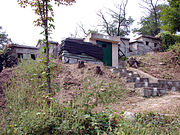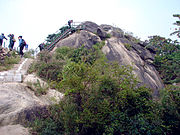Inwangsan
| Inwangsan | |
|---|---|
 Southern side of Inwangsan (2023) | |
| Highest point | |
| Elevation | 338 m (1,109 ft) |
| Geography | |
| Climbing | |
Gyeongbokgung Station | |
| Korean name | |
| Hangul | 인왕산 |
| Hanja | |
| Revised Romanization | Inwangsan |
| McCune–Reischauer | Inwangsan |
Inwangsan (
Inwangsan is famous for its view, so many painters depicted the mountain in their works such as
History
During the reign of King Sukjong of Goryeo, there was a palace in Nam-gyeong, the capital of the south, and it was recorded as Myeongak. Later in the Joseon Dynasty, the mountain was called " Baekaksan Mountain, " as there was a shrine dedicated to the mountain god. Since then, it has been called the Bukaksan Mountain because it is located in the north among the mountains surrounding Seoul. The mountain facing the south was called Namsan. The height of the mountain is 342 meters, and it is gently flat to the south, and has a triangular raised shape that looks better than the surrounding mountains. After the collapse of Goryeo and the establishment of Joseon Dynasty, King Taejo Lee Seong-gye established the palace as a royal palace, and it was honored as a royal palace. When the Joseon Dynasty was founded, a shrine to honor the mountain god was created at the Sanjeong Department. South Korea at the Gyeongbok Palace, below the mountain in 1394 (Taejo of four years), fortification and gyeongmudae, the president's office (景武臺) in here, too. (靑瓦臺) Cheong Wa Dae, currently president of the office is located below the mountain.[5]
Inwangsa Temple
Inwangsa Temple can be found at the southern foot of Inwangsan mountain. The temple was established in the early Joseon dynasty to guard Gyeongbokgung palace to the east. There are 11 shrines from five Buddhist orders leading up to Seonbawi, an unusuaul rock formation that has been used for many shamanist rites and rituals. One of the shrines in Inwangsa is Guksadang, a famous shamanist shrine that is actively used for rituals to this day.
Gallery
See also
References
- Doosan Encyber. Retrieved 2008-05-05.[permanent dead link]
- ^ Mount Inwang, Seoul - IgoUgo Reviews
- ^ 인왕산 공원 (in Korean). The official site of the Seoul Metropolitan Government. Retrieved 2008-05-05. [dead link]
- ISBN 978-1-78919-518-7.
- ^ 북악산 (in Korean). Retrieved 2018-05-26.
External links
- Inwangsan : Official Seoul City Tourism(English)
- (in Korean) Introduction of Inwangsan
- (in Korean) Travel to Inwangsan










